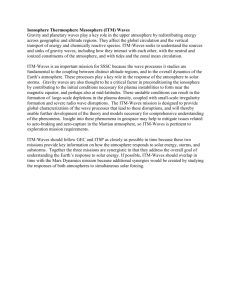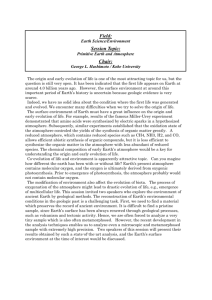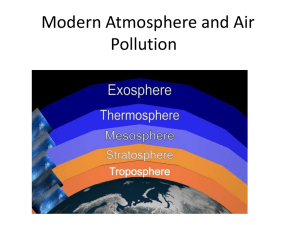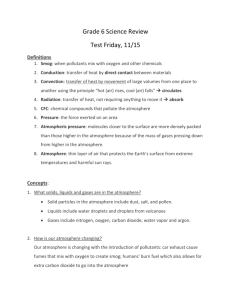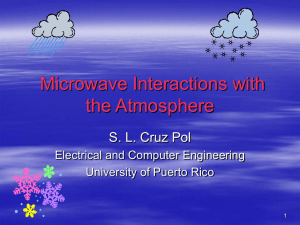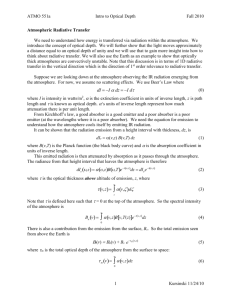AtmosRemoteSensingMicrowaveEmission09
advertisement
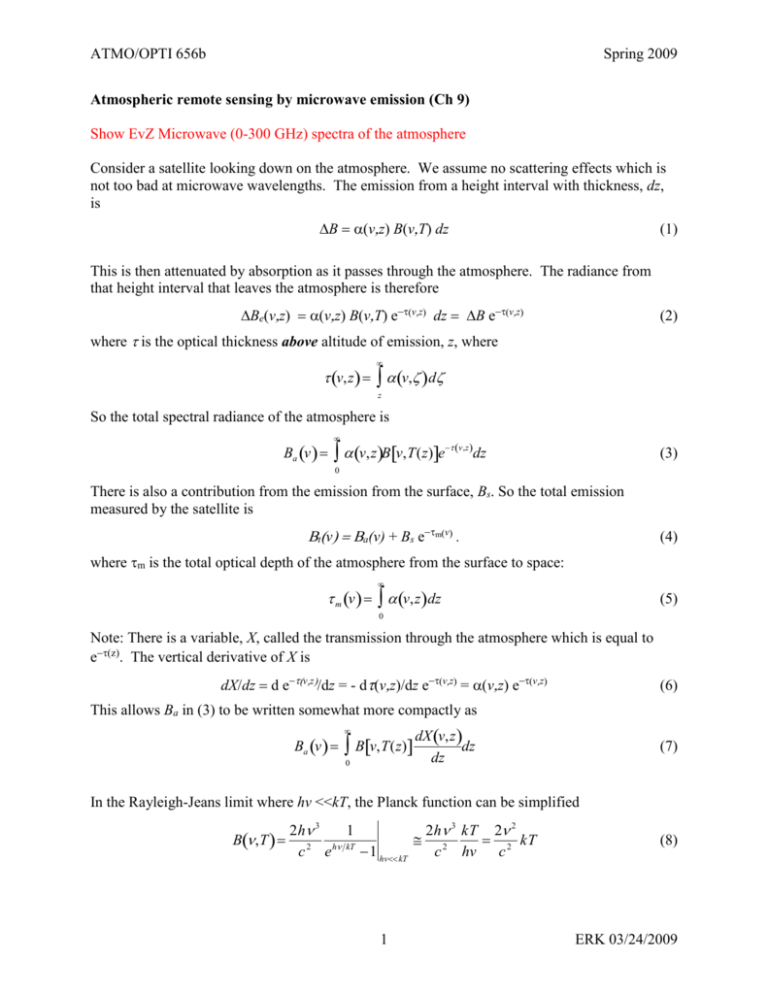
ATMO/OPTI 656b Spring 2009 Atmospheric remote sensing by microwave emission (Ch 9) Show EvZ Microwave (0-300 GHz) spectra of the atmosphere Consider a satellite looking down on the atmosphere. We assume no scattering effects which is not too bad at microwave wavelengths. The emission from a height interval with thickness, dz, is BvzBvTdz (1) This is then attenuated by absorption as it passes through the atmosphere. The radiance from that height interval that leaves the atmosphere is therefore BevzvzBvTevz dzB evz where is the optical thickness above altitude of emission, z, where v,z v, d z So the total spectral radiance of the atmosphere is Ba v v,zBv,T(z)e v,z dz 0 There is also a contribution from the emission from the surface, Bs. So the total emission measured by the satellite is v (v) + B emv. t a s (4) where m is the total optical depth of the atmosphere from the surface to space: m v v,z dz 0 Note: There is a variable, X, called the transmission through the atmosphere which is equal to ez. The vertical derivative of X is dXdzd evz/dz = - dvz/dz evz = vzevz (6) This allows Ba in (3) to be written somewhat more compactly as Ba v Bv,T(z) 0 dX v,z dz dz In the Rayleigh-Jeans limit where hv <<kT, the Planck function can be simplified 2h 3 1 2h 3 kT 2 2 B ,T 2 h kT 2 kT c e 1 hv kT c hv c 2 1 ERK 03/24/2009 ATMO/OPTI 656b Spring 2009 So, at microwave wavelengths, B is linearly proportional to T, a very nice, simplifying feature of microwave radiation. This allows us to write equations (4) and (3) as TtvTa(v) + Ts emv Ta v T(z) v,zexp v,zdzdz z 0 It is useful to write (10) as Ta v T(z)W v,zdz 0 where dX W v,z v,zexp v,zdz z dz W is known as a weighting function. In this form we see that the weighting functions, W(v,z), map the atmospheric temperature profile, T(z), to the measured brightness temperatures, Ta(v). Atmospheric Temperature Sounding This implies that if we know W(v,z) over some range of v, then we can use satellites to measure the radiances leaving the top of the atmosphere over this range of v and determine the atmospheric temperature profile. Clearly we need to understand the behavior of W(v,z) a bit better. W(v,z) has a strong vertical dependence as long as the atmospheric constituent absorption line is broadened by collisional broadening. Doppler broadened lines have a weak altitude dependence through the dependence on square root of temperature that is not terribly useful for extracting vertical information from downward looking observations. Collisional broadening has a pressure dependence that varies exponentially with altitude. Another key point is that the absorption coefficient depends on line strength and line strength depends on the number density of absorbing molecules, nabs, which can be written as ntot nabs/ntot where ntot is the total number density of the gas. If we know pressure and temperature, then we know ntot via the ideal gas law or more generally the equation of state. Therefore what we need to know is nabs/ntot which is the mixing ratio of the absorbing species. To make profiling atmospheric temperature relatively simple and straightforward, we want to use gases that are well mixed with constant and well-known mixing ratios that have nice absorption line features. The two best examples in the Earth’s atmosphere are O2 with lines near 60 GHz and a single line near 118 GHz and CO2 with rotational-vibrational bands in the IR. Note that CO2 is changing with time so there is an issue here. In the present microwave context, O2 is the gas solution. A final point is these lines cannot overlap spectrally with other lines or else interpretation of the radiances would be ambiguous. 2 ERK 03/24/2009 ATMO/OPTI 656b Spring 2009 So now let’s look at the behavior of the collisionally broadened line as a function of the collisional linewidth with depends linearly on pressure which decreases approximately exponentially with altitude. The Lorenz line shape is given as f ( ) L 0 2 L2 1 ~ 2t c 1 where L PAc mkB T To gain some insight into the dependence of f(v) on frequency consider two simple cases. First, the frequency is the line center frequency. In this case, v-v0 = 0 and mkB T 1 f ( ) ~ L PAc which scales inversely with pressure. Second, the frequency, v, is well off line center such that v-v0 >> vL in which case 1 L f ( ) 0 2 and f(v) ~ P (for fixed v) (actually P/T1/2). Now remember, the absorption coefficient, = kv,v which is k S f v v v,v v,v 0 where kv,v Sv,v f v v 0 n n m gi exp E i kT Cij hv / kT 1 e ij f v v 0 n Z c where n is the total number density of the gas = P/kBT and nm/n is the volume mixing ratio of constituent m of the gas. For a well mixed constituent like O2 where the mixing ratio is constant, and well off line center so the line shape portion of the absorption coefficient, f(v-v0), scales as P/T1/2 then the absorption coefficient scales as P/T P/T1/2 = P2 T3/2 plus the T scaling in the exp() terms. Since pressure changes approximately exponentially with altitude with a scale height of HP, P2 changes exponentially with a scale height of HP/2. This rapid scaling is helpful because it makes the weighting function more sharply defined vertically meaning the observations have more vertical information or resolution. Consider the variation of the volume absorption coefficient, kv,v = for O2 across the troposphere and stratosphere. The pressure dependence causes kv,v (far from line center) to vary by (1000mb/1mb)2 = 106. The temperature variation from 200 to 300 K causes variations via the T3/2 term of about +30%. So clearly the pressure effect dominates but the temperature 3 ERK 03/24/2009 ATMO/OPTI 656b Spring 2009 variations must be taken into account for accurate modeling of the weighting function and retrievals. Now, following EvZ, let’s assume kv,v = a depends exponentially on altitude which is a reasonable first approximation based on our argument above. v,z 0ez / H where H here is the scale height of which is HP/2 if the frequency is well off the absorption line center frequency. Plugging (19) into (12) we get z / H W v,z 0 v e exp 0 v ez / H dz 0 v exp z /H 0 v ez / H H z W v,z 0 vexp z /H mez / H where m = 0(v) H which is the total optical depth across the vertical extent of the atmosphere. Figure. Weighting functions for H=7 km. The altitude of the peak of the weighting function occurs where dW/dz = 0: 1 1 dW v,z 0 v exp z /H mez / H mez / H H H dz which occurs where m e z / H . Therefore 4 ERK 03/24/2009 ATMO/OPTI 656b Spring 2009 zmaxvHlogmv Changing the frequency, v, closer to line center causes m(v) to increase, causing the peak of the weighting function to move up in altitude. Moving farther from line center such that m(v) decreases, causes the peak altitude of the weighting function to decrease. Therefore, measuring the radiance at the top of the atmosphere at a set of frequencies around a given line provides a range of vertical sampling that allows the vertical (temperature) structure of the atmosphere to be reconstructed (within limits). There is another important point to be made here in terms of optical depth. As measured from the bottom of the atmosphere, the total optical depth across the atmosphere is m(v). Consider the optical depth as viewed from above the atmosphere. At the top of the atmosphere the optical depth is 0. As we move down into the atmosphere, the optical depth increases approximately exponentially with decreasing altitude. The optical depth from the top of the atmosphere to the peak of the weighting function is v,zmax 0 v e / H d 0 v ez max /H H 0 v e H log( m )/ H H z max 0 ve log( m )H 0 v H 0 v H 1 m 0 v H So the altitude of the peak emission is the altitude where the optical depth as measured from the top of the atmosphere is 1. This is a very important point in developing an understanding about optical depth. If you are at any point in the atmosphere and you want to know where the peak of the emission you are observing is coming from, it is coming from the points with an optical depth of ~1 relative to where you are (assuming optical depths over larger distances are larger than 1). This is a general property of optical depths and radiative transfer. 5 ERK 03/24/2009
